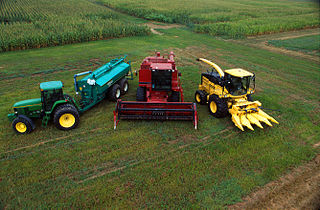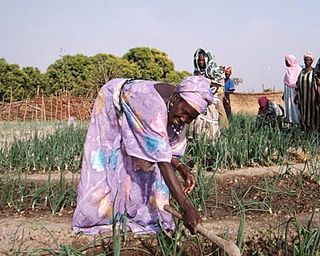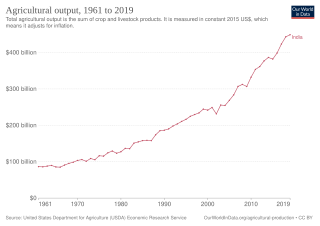This article has multiple issues. Please help improve it or discuss these issues on the talk page . (Learn how and when to remove these template messages)
|
This article has multiple issues. Please help improve it or discuss these issues on the talk page . (Learn how and when to remove these template messages)
|
| Rank | Country | Ratio (%) |
|---|---|---|
| 1 | 273 | |
| 2 | 232 | |
| 3 | 207 | |
| 4 | 193 | |
| 5 | 185 | |
| 6 | 183 | |
| 7 | 171 | |
| 8 | 162 | |
| 9 | 149 | |
| 10 | 145 |
| Rank | Country | Ratio (%) |
|---|---|---|
| 1 | 50.1 | |
| 2 | 50.6 | |
| 3 | 51.0 | |
| 4 | 52.4 | |
| 5 | 53.8 | |
| 6 | 53.8 | |
| 7 | 53.9 | |
| 8 | 54.3 | |
| 9 | 54.4 | |
| 10 | 56.0 |

This is a 2010 list of major countries by food self-sufficiency rates on a calorie supply basis. [2]
| Ranking | Country | Rate (%) | Year |
|---|---|---|---|
| 1 | 173 | 2007 | |
| 2 | 124 | 2007 | |
| 3 | 111 | 2007 | |
| 4 | 80 | 2007 | |
| 5 | 65 | 2007 | |
| 6 | 63 | 2007 | |
| 7 | 54 | 2007 | |
| 8 | 44 | 2007 | |
| 9 | 40 | 2009 | |

Agriculture encompasses crop and livestock production, aquaculture, fisheries and forestry for food and non-food products. Agriculture was the key development in the rise of sedentary human civilization, whereby farming of domesticated species created food surpluses that enabled people to live in cities. While humans started gathering grains at least 105,000 years ago, nascent farmers only began planting them around 11,500 years ago. Sheep, goats, pigs and cattle were domesticated around 10,000 years ago. Plants were independently cultivated in at least 11 regions of the world. In the twentieth century, industrial agriculture based on large-scale monocultures came to dominate agricultural output.

The almond is a species of small tree from the genus Prunus, cultivated worldwide for its seed, a culinary nut. Along with the peach, it is classified in the subgenus Amygdalus, distinguished from the other subgenera by corrugations on the shell (endocarp) surrounding the seed.

Palm oil is an edible vegetable oil derived from the mesocarp of the fruit of the oil palms. The oil is used in food manufacturing, in beauty products, and as biofuel. Palm oil accounted for about 33% of global oils produced from oil crops in 2014. Palm oils are easier to stabilize and maintain quality of flavor and consistency in ultra-processed foods, so are frequently favored by food manufacturers. On average globally, humans consumed 7.7 kg (17 lb) of palm oil per person in 2015. Demand has also increased for other uses, such as cosmetics and biofuels, creating more demand on the supply encouraging the growth of palm oil plantations in tropical countries.

An agricultural subsidy is a government incentive paid to agribusinesses, agricultural organizations and farms to supplement their income, manage the supply of agricultural commodities, and influence the cost and supply of such commodities.

Food security is the availability of food in a country and the ability of individuals within that country (region) to access, afford, and source adequate foodstuff. According to the United Nations Committee on World Food Security, food security is defined as meaning that all people, at all times, have physical, social, and economic access to sufficient, safe, and nutritious food that meets their food preferences and dietary needs for an active and healthy life. The availability of food irrespective of class, gender or region is another element of food security. There is evidence of food security being a concern many thousands of years ago, with central authorities in ancient China and ancient Egypt being known to release food from storage in times of famine. At the 1974 World Food Conference, the term "food security" was defined with an emphasis on supply; food security is defined as the "availability at all times of adequate, nourishing, diverse, balanced and moderate world food supplies of basic foodstuff to sustain a steady expansion of food consumption and to offset the fluctuations in production and prices". Later definitions added demand and access issues to the definition. The first World Food Summit, held in 1996, stated that food security "exists when all people, at all times, have physical and economic access to sufficient, safe and nutritious food to meet their dietary needs and food preferences for an active and healthy life."

A cash crop, also called profit crop, is an agricultural crop which is grown to sell for profit. It is typically purchased by parties separate from a farm. The term is used to differentiate marketed crops from staple crop in subsistence agriculture, which are those fed to the producer's own livestock or grown as food for the producer's family.
Agribusiness is the industry, enterprises, and the field of study of value chains in agriculture and in the bio-economy, in which case it is also called bio-business or bio-enterprise. The primary goal of agribusiness is to maximize profit while satisfying the needs of consumers for products related to natural resources such as biotechnology, farms, food, forestry, fisheries, fuel, and fiber.

An agricultural cooperative, also known as a farmers' co-op, is a producer cooperative in which farmers pool their resources in certain areas of activity.

The food industry is a complex, global network of diverse businesses that supplies most of the food consumed by the world's population. The food industry today has become highly diversified, with manufacturing ranging from small, traditional, family-run activities that are highly labour-intensive, to large, capital-intensive and highly mechanized industrial processes. Many food industries depend almost entirely on local agriculture, animal farms, produce, and/or fishing.
Food politics is a term which encompasses not only food policy and legislation, but all aspects of the production, control, regulation, inspection, distribution and consumption of commercially grown, and even sometimes home grown, food. The commercial aspects of food production are affected by ethical, cultural, and health concerns, as well as environmental concerns about farming and agricultural practices and retailing methods. The term also encompasses biofuels, GMO crops and pesticide use, the international food market, food aid, food security and food sovereignty, obesity, labor practices and immigrant workers, issues of water usage, animal cruelty, and climate change.

The history of agriculture in India dates back to the Neolithic period. India ranks second worldwide in farm outputs. As per the Indian economic survey 2020 -21, agriculture employed more than 50% of the Indian workforce and contributed 20.2% to the country's GDP.

Roughly one-third of Iran's total surface area is suited for farmland, but because of poor soil and lack of adequate water distribution in many areas, most of it is not under cultivation. Only 12% of the total land area is under cultivation but less than one-third of the cultivated area is irrigated; the rest is devoted to dryland farming. Some 92 percent of agricultural products depend on water. The western and northwestern portions of the country have the most fertile soils. Iran's food security index stands at around 96 percent.

Farming in North Korea is concentrated in the flatlands of the four west coast provinces, where a longer growing season, level land, adequate rainfall, and good irrigated soil permit the most intensive cultivation of crops. A narrow strip of similarly fertile land runs through the eastern seaboard Hamgyŏng provinces and Kangwŏn Province.

The Green Revolution was a period that began in the 1960s during which agriculture in India was converted into a modern industrial system by the adoption of technology, such as the use of high yielding variety (HYV) seeds, mechanised farm tools, irrigation facilities, pesticides, and fertilizers. Mainly led by agricultural scientist M. S. Swaminathan in India, this period was part of the larger Green Revolution endeavor initiated by Norman Borlaug, which leveraged agricultural research and technology to increase agricultural productivity in the developing world.

The world food price crisis refers to a period of time when the cost of food increased significantly and had a profound impact on the availability and affordability of food for people around the world. This crisis is often characterized by sharp spikes in the prices of key staple foods such as wheat, rice, and corn, as well as other agricultural commodities such as sugar and oil. The causes of the world food price crisis are complex and multifaceted, but they generally involve a combination of factors including droughts and other weather-related events, increased demand for biofuels, trade policies, and financial speculation. The consequences of the world food price crisis can be severe, particularly for people in low-income countries who spend a large portion of their income on food. According to IMF if prices eventually rise again, there will likely be sizeable differences between countries. Due to various factors, it is probable that the effect would be felt most by consumers in emerging markets and developing economies still wrestling with the effects of the pandemic.

In world demographics, the world population is the total number of humans currently living. It was estimated by the United Nations to have exceeded eight billion in mid-November 2022. It took around 300,000 years of human prehistory and history for the human population to reach one billion and only 222 years more to reach 8 billion.
Gurdev Singh Khush is an Agronomist and Geneticist who, along with mentor Henry Beachell, received the 1996 World Food Prize for his achievements in enlarging and improving the global supply of rice during a time of exponential population growth.

There were 795 million undernourished people in the world in 2014, a decrease of 216 million since 1990, despite the fact that the world already produces enough food to feed everyone—7 billion people—and could feed more than that—12 billion people.

A staple food, food staple, or simply staple, is a food that is eaten often and in such quantities that it constitutes a dominant portion of a standard diet for an individual or a population group, supplying a large fraction of energy needs and generally forming a significant proportion of the intake of other nutrients as well. For humans, a staple food of a specific society may be eaten as often as every day or every meal, and most people live on a diet based on just a small variety of food staples. Specific staples vary from place to place, but typically are inexpensive or readily available foods that supply one or more of the macronutrients and micronutrients needed for survival and health: carbohydrates, proteins, fats, minerals, and vitamins. Typical examples include grains, seeds, nuts and root vegetables. Among them, cereals, legumes and tubers account for about 90% of the world's food calorie intake.

Nuclear famine is a hypothesized famine considered a potential threat following global or regional nuclear exchange. It is thought that even subtle cooling effects resulting from a regional nuclear exchange could have a substantial impact on agriculture production, triggering a food crisis amongst the world's survivors.